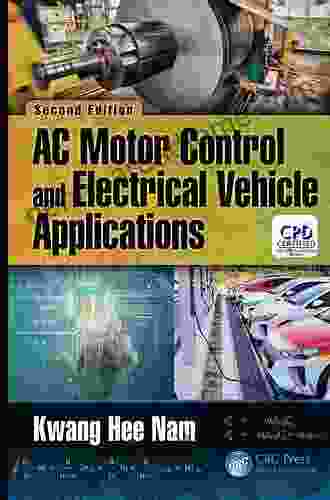AC Motor Control and Electrical Vehicle Applications: The Ultimate Guide

Electric vehicles (EVs) are rapidly becoming the future of transportation, offering numerous advantages over traditional gasoline-powered vehicles, including reduced emissions, lower operating costs, and improved energy efficiency. At the heart of every EV is the electric motor, which converts electrical energy into mechanical energy to power the vehicle. AC motors are the most widely used type of electric motor in EVs, offering several advantages over DC motors, including higher efficiency, higher power density, and reduced maintenance requirements.
4.5 out of 5
| Language | : | English |
| File size | : | 15509 KB |
| Screen Reader | : | Supported |
| Print length | : | 449 pages |
In this comprehensive guide, we will delve into the world of AC motor control and its applications in electric vehicles. We will explore the different types of AC motors, their design considerations, and the various control techniques employed to optimize their performance. We will also discuss the practical aspects of implementing AC motor control in EV drivetrains, including inverter design, power electronics, and energy management strategies.
Types of AC Motors
There are two main types of AC motors used in EVs: permanent magnet motors (PMMs) and induction motors (IMs).
Permanent magnet motors (PMMs)
PMMs are characterized by their use of permanent magnets to create the magnetic field necessary for motor operation. This eliminates the need for field windings, which reduces losses and improves efficiency. PMMs are also typically smaller and lighter than IMs of comparable power.
There are two main types of PMMs: surface-mounted PMMs and interior-mounted PMMs. Surface-mounted PMMs have the magnets mounted on the surface of the rotor, while interior-mounted PMMs have the magnets embedded within the rotor slots. Interior-mounted PMMs are generally more efficient and have higher power density than surface-mounted PMMs, but they are also more expensive to manufacture.
Induction motors (IMs)
IMs are characterized by their use of an alternating current in the stator windings to create the magnetic field necessary for motor operation. The rotor of an IM is a squirrel cage, which consists of a series of conducting bars embedded in the rotor slots. The alternating magnetic field in the stator induces currents in the rotor bars, which create a magnetic field that interacts with the stator field to produce torque.
IMs are typically less efficient than PMMs, but they are also less expensive to manufacture. IMs are also more robust and reliable than PMMs, making them a good choice for applications where cost and durability are important considerations.
Design Considerations for AC Motors
There are several key design considerations for AC motors used in EVs, including:
Power density
The power density of an AC motor is a measure of its power output per unit volume. A motor with a higher power density is smaller and lighter, which can be an important consideration for EVs, where space and weight are at a premium.
Efficiency
The efficiency of an AC motor is a measure of its ability to convert electrical energy into mechanical energy. A more efficient motor will waste less energy as heat, which can improve the range and performance of an EV.
Torque and speed characteristics
The torque and speed characteristics of an AC motor determine its ability to accelerate and climb hills. A motor with a high torque output will be able to accelerate quickly and climb hills easily, while a motor with a high speed output will be able to reach higher top speeds.
Reliability and durability
The reliability and durability of an AC motor are important considerations for EVs, which are expected to operate for many years under a variety of conditions. A reliable and durable motor will require less maintenance and downtime, which can save money and improve the overall performance of the EV.
AC Motor Control Techniques
There are a variety of AC motor control techniques that can be used to optimize the performance of an EV drivetrain. These techniques include:
Field-oriented control (FOC)
FOC is a vector control technique that uses feedback from the motor to control the stator currents and produce a desired torque and speed response. FOC is a very effective control technique that can provide high performance and efficiency.
Direct torque control (DTC)
DTC is a non-linear control technique that directly controls the torque and flux of the motor. DTC is a very fast and responsive control technique, but it can be more difficult to implement than FOC.
Scalar control
Scalar control is a simple and cost-effective control technique that uses the motor's phase voltages and currents to control the motor's speed and torque. Scalar control is not as efficient or precise as FOC or DTC, but it is a good choice for applications where cost and simplicity are important considerations.
Practical Implementation of AC Motor Control in EV Drivetrains
The practical implementation of AC motor control in EV drivetrains requires careful consideration of several key factors, including:
Inverter design
The inverter is the power electronics device that converts the DC power from the battery into the AC power required by the motor. The inverter must be carefully designed to meet the specific requirements of the motor and the EV drivetrain.
Power electronics
The power electronics in an EV drivetrain include the inverter, as well as other components such as the DC/DC converter and the battery management system. The power electronics must be carefully designed and integrated to ensure reliable and efficient operation of the EV drivetrain.
Energy management strategies
Energy management is a critical aspect of EV design. The energy management system must be designed to optimize the use of the battery and maximize the range of the EV.
AC motor control is a complex and challenging field, but it is also a very important one for the future of electric vehicles. By understanding the different types of AC motors, their design considerations, and the various control techniques employed to optimize their performance, we can design and build more efficient, more powerful, and more reliable EVs.
4.5 out of 5
| Language | : | English |
| File size | : | 15509 KB |
| Screen Reader | : | Supported |
| Print length | : | 449 pages |
Do you want to contribute by writing guest posts on this blog?
Please contact us and send us a resume of previous articles that you have written.
 Book
Book Novel
Novel Page
Page Chapter
Chapter Text
Text Story
Story Genre
Genre Reader
Reader Library
Library Paperback
Paperback E-book
E-book Magazine
Magazine Newspaper
Newspaper Paragraph
Paragraph Sentence
Sentence Bookmark
Bookmark Shelf
Shelf Glossary
Glossary Bibliography
Bibliography Foreword
Foreword Preface
Preface Synopsis
Synopsis Annotation
Annotation Footnote
Footnote Manuscript
Manuscript Scroll
Scroll Codex
Codex Tome
Tome Bestseller
Bestseller Classics
Classics Library card
Library card Narrative
Narrative Biography
Biography Autobiography
Autobiography Memoir
Memoir Reference
Reference Encyclopedia
Encyclopedia Shiwen Zhang
Shiwen Zhang William H Willimon
William H Willimon Matthew Santoro
Matthew Santoro Susan Fox
Susan Fox Larry Crabb
Larry Crabb Lance Parkin
Lance Parkin Lynn Kear
Lynn Kear William H Calvin
William H Calvin Kubi Springer
Kubi Springer Lane Lasater
Lane Lasater Kinjo Naoto
Kinjo Naoto Mustafa Umar
Mustafa Umar Marla Cone
Marla Cone Larry Burkett
Larry Burkett Lara Park
Lara Park Kitty Browne
Kitty Browne Konstantinos
Konstantinos Michel Martin
Michel Martin Klaus M Beier
Klaus M Beier Lacy Holland
Lacy Holland
Light bulbAdvertise smarter! Our strategic ad space ensures maximum exposure. Reserve your spot today!
 Michael SimmonsFollow ·13k
Michael SimmonsFollow ·13k Allan JamesFollow ·19k
Allan JamesFollow ·19k Finn CoxFollow ·2.8k
Finn CoxFollow ·2.8k Juan ButlerFollow ·2.6k
Juan ButlerFollow ·2.6k Henry David ThoreauFollow ·12.8k
Henry David ThoreauFollow ·12.8k Fyodor DostoevskyFollow ·14.8k
Fyodor DostoevskyFollow ·14.8k Alvin BellFollow ·19.6k
Alvin BellFollow ·19.6k Stephen FosterFollow ·2.6k
Stephen FosterFollow ·2.6k

 Charlie Scott
Charlie ScottQuickBooks 2024 In Depth: Your Essential Guide to...
About the Book Are you ready to elevate...

 D'Angelo Carter
D'Angelo CarterUnlocking the Mysteries of Primitive Economies: A Journey...
Prepare to embark on an...

 Milton Bell
Milton BellUnveiling the Secrets of Agile Coaching: A Comprehensive...
In the ever-evolving landscape...

 Tyler Nelson
Tyler NelsonUnveiling the Treasures of Italy: A Journey of Discovery...
Embark on an enchanting expedition into the...
4.5 out of 5
| Language | : | English |
| File size | : | 15509 KB |
| Screen Reader | : | Supported |
| Print length | : | 449 pages |
















